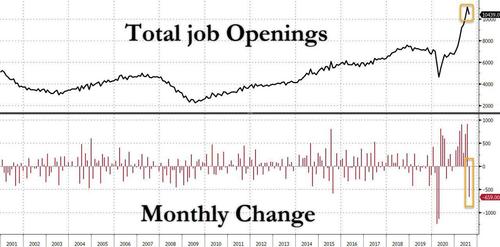by TYLER DURDEN
Some labor experts have opined that the failure of a group of workers at an Amazon warehouse in Bessemer, Ala. to succeed in their battle to form a union should blunt the nascent revival in the American labor movement. But as the number of American workers who decided to quit their jobs during the prior month soared to a record high north of 4MM, the number of open jobs in the US remains north of 10MM. For the first time in decades, workers have the power in the labor market. And they’re using this newfound leverage to launch a flurry of strikes, creating another headache for their preoccupied bosses.
According to Reuters, thousands of workers are on strike across the US. Data maintained by Cornell show 176 strikes have been called this year, with 17 in October alone.
They’re demanding high pay and better conditions, among other things, and some of them are already winning or at least reaching a settlement. Just this weekend, Hollywood make-up artists and camera operators reached a deal to avoid a walkout.
This victory in Hollywood, combined with the latest JOLTS numbers, are bound to be encouraging.
Kevin Bradshaw, an employee at Kellogg’s cereal plant in Memphis, Tennessee, where most of North America’s Frosted Flakes are made, told Reuters he opposes cuts to healthcare coverage, retirement benefits and vacation time that union officials say the company is pushing for from about 1,400 workers. They have been on strike since Oct. 5 at plants in Michigan, Nebraska, Pennsylvania and Tennessee.
“Enough is enough,” said Bradshaw, vice president of Bakery, Confectionary, Tobacco Workers and Grain Millers International Union Local 252G at the Memphis plant. “We can’t afford to keep giving away things to a company that financially has made record-breaking returns.”
Kellogg’s labor activists complain that their members were deemed “essential” during the start of the COVID pandemic, yet, despite this, the manner in which they are treated by management hasn’t changed.
Another thing workers hope will benefit them in their struggle (although, in the end, disappointment isn’t just possible, but likely): the Democrats are back in control in Washington. But workers who expect President Biden to have their backs should remember that the Dems and President Biden are restricted by their corporate backers.
Still, so far, at least 176 strikes have been launched this year, including 17 in October alone, according to data from Cornell’s Labor Action Tracker.
“Workers are on strike for a better deal and a better life,” said Liz Shuler, president of the AFL-CIO, the country’s biggest labor federation, during a conference for business journalists.
“The pandemic really did lay bare the inequities of our system and working people are refusing to return to crappy jobs that put their health at risk,” she added, noting that the term #Striketober was trending on Twitter.
There have been some setbacks, yet overall, union laaders are still hopeful. Union membership has declined to just 11% of workers today, down from more than 20% in late 1983. What’s more, Americans’ support for unions has risen to its highest level in decades. 68% of Americans now approve of unions, the highest level since 1965, according to Gallup.
“We have entered a new era in labor relations,” said Harley Shaiken, professor emeritus of labor at the University of California Berkeley. “Workers feel they’re in the driver’s seat and there’s plenty of lost ground to make up.”
“What we’re seeing is a fight to return or at least stay in the middle class,” he said.
Back in April, President Biden – who has struggled to appeal to working-class whites by playing up his ties to organized labor – created a task force to promote labor organizing. Biden also spoke out in support of the workers in Bessemer before their vote, which organizers insist was unfairly tampered with by Amazon.
Other setbacks for the bosses have popped up in Beaumont, Texas, where Exxon Mobil ordered a lockout of 650 workers from its refinery and an adjacent plant since May after a local chapter of the United Steelworkers union refused to submit a contract proposal. Union leaders have scheduled a vote on the contract for Tuesday, but have urged members to reject it. Some members are moving to try and decertify the union.
Exxon said the lockout was necessary to avoid the disruption of a possible strike and the changes to seniority it wants to impose were needed to ensure profitability. Some union members have moved to decertify the union. Over at John Deere, which makes farm equipment, 90% of its 10K workers recently launched a strike.
And according to Reuters, one industry that’s ripe for labor unrest is health-care.
More than 28,000 healthcare workers at 13 Southern California Kaiser Permanente hospitals and hundreds of medical centers voted overwhelmingly earlier this month to authorize a strike. They want more pay and higher levels of staffing to reduce burnout worsened by the pandemic. That demand is echoed by nearly 2,000 healthcare workers who have been on strike since Oct. 1 in Buffalo, New York. “We’ve been working short at Mercy for five years,” Kathy Kelly, who has been a nurse for 38 years at the Catholic Health System’s Mercy Hospital, said while on break from picketing. “Enough’s enough. We can only give so much.”
Anybody searching for more data on labor actions can check the ILR data from Cornell, which can be found here








